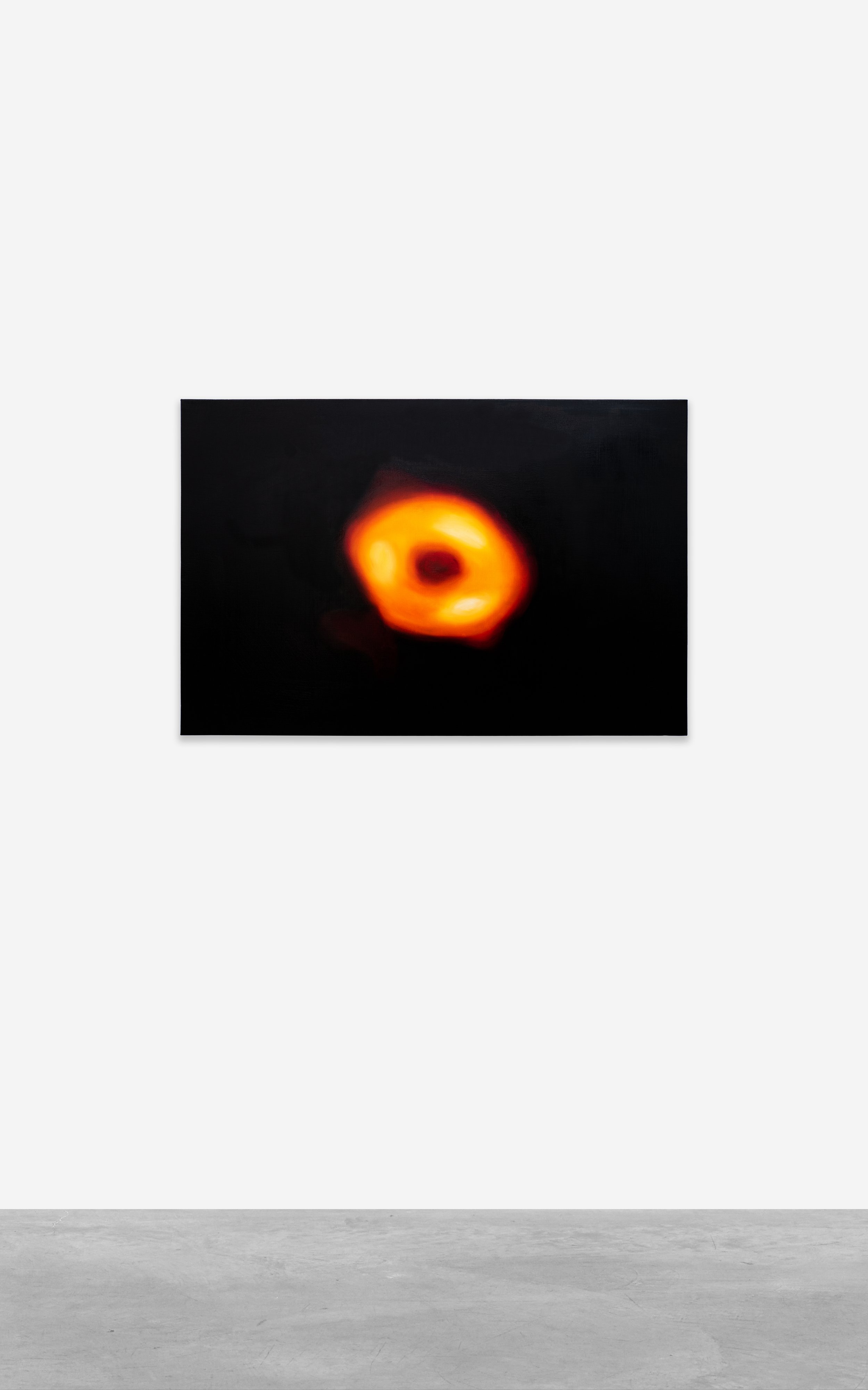Sagittarius A*, 2022
Sagittarius A*, 2022
Oil on linen
61 x 91 cm (24 x 36 in)
Sagittarius A* (2022) is inspired by the historic achievement of capturing the first image of the supermassive black hole at the center of the Milky Way. This work not only honors the celestial wonder itself but also pays tribute to the extraordinary global collaboration among scientists that made this visualization possible. Drawing from the inaugural image of Sagittarius A*, the colossal black hole at the heart of our galaxy, the painting interprets the mesmerizing interplay of light and gravity, shadow and illumination, that defines such cosmic phenomena. More than a simple depiction of a distant astronomical marvel, Sagittarius A* emphasizes the spirit of human cooperation and the shared pursuit of knowledge. It celebrates the synchronized efforts of scientists across continents, who, through a network of telescopes, synthesized data to reveal a previously unseen facet of our universe. This artwork stands as a testament to the power of collective human endeavor and the insatiable curiosity that drives us to explore both the depths of space and the potential of our united aspirations.
Q: Your works Sagittarius A (2022) and Powehi (2022) are both based on the theme of black holes. Could you talk about how you transformed scientific images into artistic creations?
Tan Mu: The core of these works lies in the process of generating black hole images, not just the images themselves. Black hole images are not captured through regular cameras; instead, data is collected from telescopes around the world and visualized. It’s somewhat like the process of printmaking, where dispersed data is consolidated into a complete image. This collective observation and data collaboration fascinated me because it represents humanity’s shared curiosity and exploration of cosmic phenomena. The study of black holes is an ever-evolving field, with humanity capturing the first-ever image of the M87 galaxy’s black hole in 2019, and in 2022, the image of the Milky Way’s center, Sagittarius A*. These ongoing discoveries excite me. In my work, I document these scientific milestones, while also reflecting on how, with technological advancements, we may witness even more black hole images in the future. This sense of "timeliness" makes me feel that my work is not just a record of present scientific discoveries but also a glimpse into the possibilities of the future.
Q: You mentioned that the creation of black hole images is a collective effort. How has this "collectivity" inspired your artistic process?
Tan Mu: The generation of black hole images is a global collaboration, involving observatories and telescopes from all over the world. This collective observation and data integration deeply moved me. It’s not just a product of science and technology, but also a symbol of human collective effort. This "collectivity" made me realize that both scientific discoveries and artistic creation share something in common—they both require collaboration, curiosity, and continuous exploration. In my work, I try to capture the spirit of this collective endeavor and transform it into a visual language. Almost all technological and scientific achievements reflect human collective collaboration. While most of my paintings don’t depict people directly, through these sophisticated instruments or the images they capture, we can feel the immense human collaboration behind them, and this collective labor is conveyed in my brushstrokes, one by one, layer by layer.
Q: How do you view the relationship between the scientific and artistic aspects of black hole images?
Tan Mu: The black hole images are the result of visualizing scientific data, but they are also inherently artistic. Scientists use complex calculations and data processing, or scientific colorization, to transform the invisible phenomena of black holes into visible images. This process is similar to artistic creation, especially in how abstract concepts are transformed into concrete visual forms. The process of visualizing black hole images is full of tension between "accuracy" and "uncertainty." While scientists generate these images through extensive data and high-precision calculations, there are still errors and adjustments made by humans. For example, to make the image easier to understand, scientists often add colors. This "uncertainty" fascinates me because it reveals a commonality between science and art—we are both trying to explain the invisible phenomena through visible forms. This attempt is full of challenges and possibilities, and it’s one of the core themes I explore in my work.
Q: You used a black background in your creations. What is the significance of this design choice?
Tan Mu: The black background is an important visual element in my work, whether in space-themed pieces like Powehi (2022), Sagittarius A (2022), or Moldavite (2020), or in depictions of the microscopic world such as cells, DNA, and materials like Silicon (2021, 2023). The use of black not only highlights the structure, texture, and shape of the central objects but also creates a deep, mysterious atmosphere. This design choice reminds me of the "objectified" perspective in scientific observation—whether as scientists or artists, we both attempt to understand the world through observation and analysis. The black background also allows me to focus more on capturing the shape and texture of the black hole while metaphorically referencing the unknown and infinite nature of the universe.



